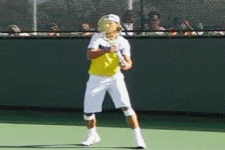I would say it's just the opposite. If you are taking your eye off of the ball to "look behind" or anticipate where the ball is going to be you will not have enough time to make adjustments with your swing.
I believe the research with baseball, cricket, and tennis players all agree.
I picture a hitter 'looking back' at a ball in the catchers mit. Strikeeeeeeeeeeeee 3 you're out.








